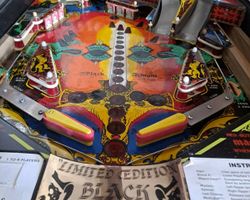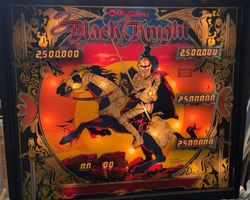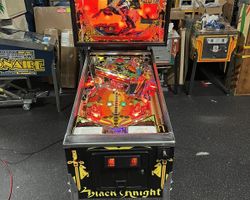Black Knight (Limited Edition)

Average Prices: USD $2,200 to $4,700
Produced: June, 1981
Production Run: 600 units
Machine Type: Solid State Electronic
MPU: Williams System 7
Players: 4
Design by: Steve Ritchie
Art by: Tony Ramunni
Sound by: John Kotlarik
Software by: Larry DeMar
Black Knight (Limited Edition) holds a significant place in the history of pinball, a machine that not only captivated players upon its release but also left an indelible mark on game design. Manufactured by Williams Electronic Games, Inc., this solid-state electronic (SS) machine debuted in June 1981, emerging at a critical juncture when video games were beginning to reshape the arcade landscape. Its purpose was clear: to demonstrate pinball’s continued relevance and innovation. The Black Knight theme, steeped in medieval lore and featuring a menacing armored adversary, provided a compelling backdrop for the playfield’s unique mechanics.
The genesis of Black Knight is largely attributed to Steve Ritchie, who served as the primary designer, conceptualizer, and mechanical engineer for the project. His vision was pivotal in shaping the game’s core identity and its groundbreaking features. Complementing Ritchie's mechanical ingenuity was Tony Ramunni, the artist responsible for the game's distinctive visual identity, including the playfield and backglass artwork that would become synonymous with the Black Knight persona. Electronics and software development were handled by Larry DeMar, integrating the cutting-edge (for its time) Williams System 7 MPU. Sound design was crafted by John Kotlarik, with Paul Dussault specifically credited for the custom speech processing, a feature that significantly enhanced player immersion. The Black Knight (Limited Edition) was produced in a relatively small run of 600 units, making it a distinctive variant. This Limited Edition version is visually and functionally identical to the original Black Knight released in 1980, with a few subtle distinctions: a gold emblem on the game’s apron, upgraded microswitches on the ball trough for improved reliability, and the inclusion of gold-leaf paint accents on the backglass. These refinements underscore its status as a special release, offering minor but noteworthy improvements over its predecessor.
Signature Features and Design
Black Knight distinguishes itself through several innovative features that profoundly impacted its gameplay and presentation. The most prominent of these is the two-level playfield, a design choice that adds unparalleled depth and strategic complexity. This multi-leveled arrangement creates distinct upper and lower play areas, each with its own set of objectives and shot opportunities, effectively doubling the game's interactive space and challenging players to adapt their strategies dynamically.
Another defining innovation is the "Magna-Save" feature. Positioned near the outlanes, Magna-Save is a player-controlled magnetic ball save mechanism. By activating a dedicated button, players can momentarily engage a magnet to pull a draining ball back onto the playfield. This feature introduces a layer of player agency and risk-reward, demanding precise timing and awareness to avert an untimely end to a ball. Its inclusion was a direct response to the need for greater player involvement beyond simple flipper skills.
The machine also incorporates a 3-ball multiball, a chaotic and high-scoring mode that amplifies the game's excitement. Custom speech, delivered by a menacing voice representing the Black Knight, further enhances the thematic experience. The speech adds personality and urgency to the gameplay, guiding players through objectives and reacting to their performance. Tony Ramunni's artwork ties these elements together, with a strong, dark medieval aesthetic that complements the machine's imposing presence. The detailed illustrations of armored knights, castles, and heraldic symbols contribute to a cohesive and immersive environment, establishing a visual standard for many games that followed.
Playfield and Mechanics
The Black Knight playfield is a meticulously designed arena, fostering a blend of fast action and strategic shot-making. Its most striking aspect is the two-level layout. The lower playfield, the primary area of action, features four flippers in total: two standard flippers at the bottom of the cabinet and two additional flippers positioned on the upper right side, controlling access and shots on the upper playfield. Players initiate balls via a manual plunger.
Key targets on the lower playfield include twelve drop targets, arranged in four banks of three. Successfully clearing these banks is crucial for advancing game objectives and accumulating points. A single pop bumper provides unpredictable rebound action, keeping balls in play and occasionally setting up unexpected shots. The presence of three ramps adds significant flow to the game; two ramps lead directly to the upper playfield, while a third may offer distinct scoring opportunities or lead to the ball lock for multiball. Spinners are strategically placed to reward accurate shots with rapid point accumulation and satisfying auditory feedback.
The upper playfield is accessed primarily by accurate shots from the lower playfield's upper right flippers or the ramps. This elevated area often features its own set of targets and a unique loop, known as the "bonus multiplier loop." The design philosophy behind this multi-level layout was to create a sense of verticality and progression. Shots made on the lower playfield might enable access to the upper, which in turn could unlock multiball or higher scoring opportunities. This layered design demands both precise aim and strategic thinking, encouraging players to master transitions between the two levels. The artwork across the playfield maintains the dark, imposing medieval theme, with stylized knights and castle elements framing the targets and shots. Original playfield inserts, which were often shaped like "gems," were known to be prone to heat shrinkage, a common characteristic of machines from this era, though replacement components are now available that improve both cosmetic appearance and reliability.
Gameplay Dynamics
The gameplay dynamics of Black Knight are centered around a challenging yet rewarding progression system, emphasizing shot accuracy, strategic use of features, and an exhilarating multiball experience. The core objective often revolves around clearing the drop target banks, which can light various awards or prepare for multiball. The four banks of three drop targets serve as a primary focus, and their successful completion is key to progressing through the game's objectives.
A major highlight is the 3-ball multiball, a fast and intense segment of play. To initiate multiball, players must typically lock two balls, often by hitting specific targets or ramps on the playfield. The third ball is then plunged, launching a frantic scoring opportunity where all three balls are in play simultaneously. The game features the ability to "steal" locked balls from opponents in a multi-player game, adding a competitive edge that encourages strategic ball locking and careful play.
The Magna-Save feature is a critical defensive tool that heavily influences player strategy. Learning the precise timing to activate the magnet and save a draining ball is a skill that distinguishes adept players. While it offers a reprieve, overuse drains the magna-save lamp, requiring additional shots to relight it. The bonus multiplier loop, often located on the upper playfield, provides a consistent target for accumulating bonus points, adding another layer of strategic depth. The game can be adjusted to increase difficulty, for instance, by requiring the bonus multiplier loop to be hit to light the multiball lock, making the primary objective more challenging. Despite its age, the game's scoring system feels intuitive, rewarding players for completing target banks, hitting ramps, and skillfully managing multiball. The custom speech provides ongoing feedback, acknowledging player achievements and maintaining the thematic tension. While the game's background music can become repetitive for some players, its attract mode sounds and speech are generally praised for their effectiveness in building atmosphere.
Reception and Legacy
Upon its release, Black Knight garnered a positive reception, establishing itself as a pivotal pinball machine. It is widely acknowledged as a landmark title, primarily due to its groundbreaking two-level playfield design, which was unprecedented in its era and set a new standard for complexity and player engagement. This innovation, coupled with the introduction of the player-controlled Magna-Save, signaled a new direction for pinball, demonstrating that the medium could evolve beyond traditional layouts.
Feedback from the pinball community has consistently highlighted the machine’s robust gameplay and enduring appeal. Players frequently commend its "great shots" and "rock tight gameplay," noting that the layout remains challenging and satisfying even decades after its debut. The theme is universally regarded as well-executed, with Tony Ramunni's artwork receiving particular praise for its importance in establishing a cohesive and visually compelling experience, despite some minor feedback suggesting the artwork was "just OK" compared to the playfield. The chaotic and fast-paced multiball is a consistent favorite, enhancing the game's excitement. The custom speech, while early for its time, is also cited as a significant enhancement, adding to the game's distinctive personality.
While the machine is celebrated, some criticisms exist. The background music is often cited as repetitive, with many players opting to turn it down or off during extended play sessions. Some older units may also present minor drain issues, such as balls occasionally draining after an imperfect shot from the upper right flipper or if the lower loop is not properly adjusted. Original playfield inserts, designed with a distinct "gem" shape, were prone to heat-related shrinkage, impacting their aesthetic over time, though modern replacement parts have addressed this.
The legacy of Black Knight extends far beyond its initial run of 600 Limited Edition units. It is frequently referred to as a "classic" and a "game for the ages," influencing numerous subsequent pinball designs, particularly those incorporating multi-level playfields. Its innovative features helped revitalize the pinball industry during a period dominated by burgeoning video games, signaling a shift towards more complex and interactive experiences that justified the transition to "quarter a play." Black Knight solidified Steve Ritchie's reputation as a prominent designer and remains a highly sought-after machine by collectors and enthusiasts who appreciate its historical significance, innovative design, and timeless gameplay. Its enduring presence in the pinball community underscores its status as a foundational piece of pinball history.
Sponsored Links
 Ebay Listings
Ebay Listings
 Auction Results
Auction Results
| Cost | Location | Date |
|---|---|---|
| USD $5,999 |  United States United States |
20 December, 2025 |
| USD $3,999 |  United States United States |
13 May, 2025 |
| USD $2,400 |  California, United States California, United States |
13 March, 2025 |
| USD $2,000 |  Illinois, United States Illinois, United States |
15 December, 2024 |
| USD $7,889 |  Florida, United States Florida, United States |
07 August, 2022 |
| GBP £1,880 |  Haverhill, United Kingdom Haverhill, United Kingdom |
05 March, 2022 |
| USD $3,000 |  California, United States California, United States |
25 January, 2021 |


Private Policy · Search Website · Contact Us
As an eBay Partner, we may earn a commission from qualifying purchases made through links on this site, at no additional cost to you.
All trademarks and copyrighted materials remain property of their respective owners. All other content copyright 2007 - 2026 Pinpedia.




